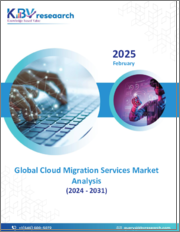
|
시장보고서
상품코드
1722377
세계의 클라우드 마이그레이션 서비스 시장 : 규모, 점유율, 성장 분석, 플랫폼 유형별, 전개별, 기업 규모별, 최종 사용자별, 지역별 산업 예측(2025-2032년)Cloud Migration Services Market Size, Share, and Growth Analysis, By Platform Type (Solution, Service), By Deployment (Public, Private), By Enterprise Size, By End-user, By Region - Industry Forecast 2025-2032 |
||||||
세계의 클라우드 마이그레이션 서비스 시장 규모는 2023년 113억 달러였고, 예측 기간(2025-2032년) 중 CAGR 24.5%로 예상되며, 2024년 140억 7,000만 달러에서 2032년까지 812억 1,000만 달러로 성장할 전망입니다.
세계의 클라우드 마이그레이션 서비스 시장은 비용 효율성, 유연성, 확장성 및 협업 강화에 대한 수요에 힘입어 큰 성장을 이루고 있습니다. 기업은 IT 리소스를 동적으로 조정하여 효율성을 높이고 리소스 할당을 개선할 수 있습니다. 또한, 클라우드 환경은 접근성 높은 플랫폼을 통해 팀 협업을 개선합니다. 기업은 핵심 역량에 집중하여 리소스 활용을 최적화할 수 있습니다. 그러나 데이터 보안 문제, 규정 준수 문제, 복잡한 마이그레이션 프로세스와 같은 과제는 여전히 시장 확장을 저해하는 요소입니다. 그럼에도 불구하고, 클라우드와 온프레미스 환경을 혼합하는 하이브리드 클라우드 솔루션과 멀티 클라우드 전략의 도입 증가에 힘입어 시장은 계속해서 성장하고 있습니다.
목차
소개
- 조사의 목적
- 조사 범위
- 정의
조사 방법
- 정보 조달
- 2차와 1차 데이터의 방법
- 시장 규모 예측
- 시장의 전제조건과 제한
주요 요약
- 세계 시장 전망
- 공급과 수요 동향 분석
- 부문별 기회 분석
시장 역학과 전망
- 시장 개요
- 시장 규모
- 시장 역학
- 성장 촉진요인과 기회
- 억제요인과 과제
- Porter's Five Forces 분석
주요 시장 인사이트
- 중요성공요인
- 경쟁도
- 주요 투자 기회
- 시장 생태계
- 시장의 매력 지수(2024년)
- PESTEL 분석
- 거시경제지표
- 밸류체인 분석
- 가격 분석
- 규제 상황
- 사례 연구
- 기술 분석
클라우드 마이그레이션 서비스 시장 규모 : 플랫폼 유형별 CAGR(2025-2032년)
- 시장 개요
- 솔루션
- 인프라 전환
- 플랫폼 마이그레이션
- 데이터베이스 마이그레이션
- 애플리케이션 마이그레이션
- 스토리지 마이그레이션
- 서비스
- 전문 서비스
- 매니지드 서비스
클라우드 마이그레이션 서비스 시장 규모 : 전개별 CAGR(2025-2032년)
- 시장 개요
- 퍼블릭
- 프라이빗
- 하이브리드
클라우드 마이그레이션 서비스 시장 규모 : 기업 규모별 CAGR(2025-2032년)
- 시장 개요
- 대기업
- 중소기업
클라우드 마이그레이션 서비스 시장 규모 : 최종 사용자별 CAGR(2025-2032년)
- 시장 개요
- IT 및 통신
- BFSI
- 헬스케어
- 정부 및 공공 부문
- 제조업
- 자동차
- 소매 및 소비재
- 미디어 및 엔터테인먼트
- 기타
클라우드 마이그레이션 서비스 시장 규모 : 지역별 CAGR(2025-2032년)
- 북미
- 미국
- 캐나다
- 유럽
- 독일
- 스페인
- 프랑스
- 영국
- 이탈리아
- 기타 유럽
- 아시아태평양
- 중국
- 인도
- 일본
- 한국
- 기타 아시아태평양
- 라틴아메리카
- 브라질
- 기타 라틴아메리카
- 중동 및 아프리카
- GCC 국가
- 남아프리카
- 기타 중동 및 아프리카
경쟁 정보
- 상위 5개사 비교
- 주요 기업의 시장 포지셔닝(2024년)
- 주요 시장 기업이 채용한 전략
- 최근 시장 동향
- 기업의 시장 점유율 분석(2024년)
- 주요 기업의 기업 프로파일
- 기업의 상세
- 제품 포트폴리오 분석
- 기업의 부문별 점유율 분석
- 수익의 전년대비 비교(2022-2024년)
주요 기업 프로파일
- Accenture(Ireland)
- Amazon Web Services(AWS)(USA)
- Microsoft Azure(USA)
- Google Cloud Platform(GCP)(USA)
- IBM Cloud(USA)
- Oracle Cloud(USA)
- Wipro(India)
- Tata Consultancy Services(TCS)(India)
- Infosys(India)
- HCL Technologies(India)
- Cognizant(USA)
- Capgemini(France)
- Kyndryl(USA)
- Devoteam(France)
- Nuvento(USA)
- IT Svit(Ukraine)
- Cloud4C(India)
- Persistent Systems(India)
결론과 권고
JHS 25.05.27Cloud Migration Services Market size was valued at USD 11.3 billion in 2023 and is poised to grow from USD 14.07 billion in 2024 to USD 81.21 billion by 2032, growing at a CAGR of 24.5% during the forecast period (2025-2032).
The global cloud migration services market is experiencing significant growth, fueled by demand for cost-efficiency, flexibility, scalability, and enhanced collaboration. By minimizing the need for extensive on-premises maintenance and hardware, cloud services contribute to reducing total ownership costs. Businesses benefit from the ability to dynamically adjust IT resources, enhancing efficiency and better resource allocation. Additionally, cloud environments facilitate improved team collaboration through accessible platforms. Companies can focus on core competencies, optimizing resource utilization. However, challenges such as data security concerns, regulatory compliance issues, and complex migration processes still pose threats to market expansion. Nonetheless, the market continues to thrive, driven by the rising adoption of hybrid cloud solutions and multi-cloud strategies that blend cloud and on-premises environments.
Top-down and bottom-up approaches were used to estimate and validate the size of the Cloud Migration Services market and to estimate the size of various other dependent submarkets. The research methodology used to estimate the market size includes the following details: The key players in the market were identified through secondary research, and their market shares in the respective regions were determined through primary and secondary research. This entire procedure includes the study of the annual and financial reports of the top market players and extensive interviews for key insights from industry leaders such as CEOs, VPs, directors, and marketing executives. All percentage shares split, and breakdowns were determined using secondary sources and verified through Primary sources. All possible parameters that affect the markets covered in this research study have been accounted for, viewed in extensive detail, verified through primary research, and analyzed to get the final quantitative and qualitative data.
Cloud Migration Services Market Segments Analysis
Global Cloud Migration Services Market is segmented by Platform Type, Deployment, Enterprise Size, End-user and region. Based on Platform Type, the market is segmented into Solution and Service. Based on Deployment, the market is segmented into Public, Private and Hybrid. Based on Enterprise Size, the market is segmented into Large Size Enterprises and SMEs. Based on End-user, the market is segmented into IT & Telecommunications, BFSI, Healthcare, Government & Public Sector, Manufacturing, Automotive, Retail & Consumer Goods, Media & Entertainment and Others. Based on region, the market is segmented into North America, Europe, Asia Pacific, Latin America and Middle East & Africa.
Driver of the Cloud Migration Services Market
The cloud migration services market is primarily driven by the need for IT simplification and enhanced agility. Organizations can streamline their operations by transitioning to cloud services, effectively alleviating the complexities associated with managing traditional IT infrastructure. This shift allows businesses to focus on strategic initiatives and their essential functions, fostering innovation. Furthermore, cloud migration facilitates the rapid deployment of various services and applications, enabling organizations to respond swiftly to market demands and technological advancements. As companies prioritize efficiency and adaptability, the demand for cloud migration services continues to grow, highlighting its significance in today's competitive landscape.
Restraints in the Cloud Migration Services Market
The Cloud Migration Services market faces several restraints due to the complexity of the migration process, which requires meticulous planning and substantial time investment to avoid disruptions in operations. Moreover, many organizations rely on legacy systems that often lack the capability to seamlessly integrate with cloud solutions. These dependencies can further complicate migration initiatives, creating challenges that hinder overall market growth. As businesses navigate these technological hurdles, the intricacies involved in transitioning to cloud-based environments may impede their willingness to adopt such services, thereby restricting the expansion of the Cloud Migration Services market.
Market Trends of the Cloud Migration Services Market
The Cloud Migration Services market is witnessing a notable trend towards enhanced compliance and security, driven by escalating regulatory demands and rising incidents of data breaches. As organizations prioritize the safeguarding of sensitive data, leading service providers are increasingly incorporating advanced security features, tailored compliance solutions, robust encryption, and identity management systems into their offerings. This shift highlights a growing expectation among businesses for migration solutions that not only facilitate the transition to the cloud but also ensure comprehensive data protection and regulatory adherence throughout the process. Consequently, this focus is reshaping service offerings, making security a pivotal factor in cloud migration strategies.
Table of Contents
Introduction
- Objectives of the Study
- Scope of the Report
- Definitions
Research Methodology
- Information Procurement
- Secondary & Primary Data Methods
- Market Size Estimation
- Market Assumptions & Limitations
Executive Summary
- Global Market Outlook
- Supply & Demand Trend Analysis
- Segmental Opportunity Analysis
Market Dynamics & Outlook
- Market Overview
- Market Size
- Market Dynamics
- Drivers & Opportunities
- Restraints & Challenges
- Porters Analysis
- Competitive rivalry
- Threat of substitute
- Bargaining power of buyers
- Threat of new entrants
- Bargaining power of suppliers
Key Market Insights
- Key Success Factors
- Degree of Competition
- Top Investment Pockets
- Market Ecosystem
- Market Attractiveness Index, 2024
- PESTEL Analysis
- Macro-Economic Indicators
- Value Chain Analysis
- Pricing Analysis
- Regulatory Landscape
- Case Studies
- Technology Analysis
Global Cloud Migration Services Market Size by Platform Type & CAGR (2025-2032)
- Market Overview
- Solution
- Infrastructure Migration
- Platform Migration
- Database Migration
- Application Migration
- Storage Migration
- Service
- Professional Services
- Managed Services
Global Cloud Migration Services Market Size by Deployment & CAGR (2025-2032)
- Market Overview
- Public
- Private
- Hybrid
Global Cloud Migration Services Market Size by Enterprise Size & CAGR (2025-2032)
- Market Overview
- Large Size Enterprises
- SMEs
Global Cloud Migration Services Market Size by End-user & CAGR (2025-2032)
- Market Overview
- IT & Telecommunications
- BFSI
- Healthcare
- Government & Public Sector
- Manufacturing
- Automotive
- Retail & Consumer Goods
- Media & Entertainment
- Others
Global Cloud Migration Services Market Size & CAGR (2025-2032)
- North America (Platform Type, Deployment, Enterprise Size, End-user)
- US
- Canada
- Europe (Platform Type, Deployment, Enterprise Size, End-user)
- Germany
- Spain
- France
- UK
- Italy
- Rest of Europe
- Asia Pacific (Platform Type, Deployment, Enterprise Size, End-user)
- China
- India
- Japan
- South Korea
- Rest of Asia-Pacific
- Latin America (Platform Type, Deployment, Enterprise Size, End-user)
- Brazil
- Rest of Latin America
- Middle East & Africa (Platform Type, Deployment, Enterprise Size, End-user)
- GCC Countries
- South Africa
- Rest of Middle East & Africa
Competitive Intelligence
- Top 5 Player Comparison
- Market Positioning of Key Players, 2024
- Strategies Adopted by Key Market Players
- Recent Developments in the Market
- Company Market Share Analysis, 2024
- Company Profiles of All Key Players
- Company Details
- Product Portfolio Analysis
- Company's Segmental Share Analysis
- Revenue Y-O-Y Comparison (2022-2024)
Key Company Profiles
- Accenture (Ireland)
- Company Overview
- Business Segment Overview
- Financial Updates
- Key Developments
- Amazon Web Services (AWS) (USA)
- Company Overview
- Business Segment Overview
- Financial Updates
- Key Developments
- Microsoft Azure (USA)
- Company Overview
- Business Segment Overview
- Financial Updates
- Key Developments
- Google Cloud Platform (GCP) (USA)
- Company Overview
- Business Segment Overview
- Financial Updates
- Key Developments
- IBM Cloud (USA)
- Company Overview
- Business Segment Overview
- Financial Updates
- Key Developments
- Oracle Cloud (USA)
- Company Overview
- Business Segment Overview
- Financial Updates
- Key Developments
- Wipro (India)
- Company Overview
- Business Segment Overview
- Financial Updates
- Key Developments
- Tata Consultancy Services (TCS) (India)
- Company Overview
- Business Segment Overview
- Financial Updates
- Key Developments
- Infosys (India)
- Company Overview
- Business Segment Overview
- Financial Updates
- Key Developments
- HCL Technologies (India)
- Company Overview
- Business Segment Overview
- Financial Updates
- Key Developments
- Cognizant (USA)
- Company Overview
- Business Segment Overview
- Financial Updates
- Key Developments
- Capgemini (France)
- Company Overview
- Business Segment Overview
- Financial Updates
- Key Developments
- Kyndryl (USA)
- Company Overview
- Business Segment Overview
- Financial Updates
- Key Developments
- Devoteam (France)
- Company Overview
- Business Segment Overview
- Financial Updates
- Key Developments
- Nuvento (USA)
- Company Overview
- Business Segment Overview
- Financial Updates
- Key Developments
- IT Svit (Ukraine)
- Company Overview
- Business Segment Overview
- Financial Updates
- Key Developments
- Cloud4C (India)
- Company Overview
- Business Segment Overview
- Financial Updates
- Key Developments
- Persistent Systems (India)
- Company Overview
- Business Segment Overview
- Financial Updates
- Key Developments



















